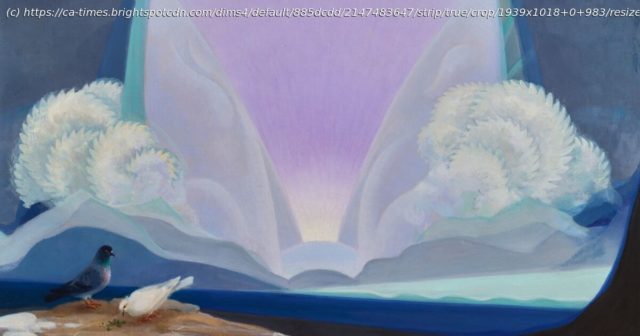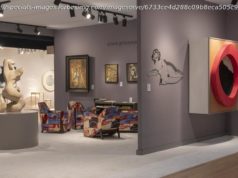The Works Progress Administration indelibly shaped the work of the Transcendental Painting Group. An exhibition about the artists is on view at LACMA.
Isolated in the rural American Southwest and navigating the harsh realities of poverty in the 1930s, a small group of artists made sublime abstract art that sought to intuitively connect viewers to a spiritual realm. These artists gathered in an adobe home in Santa Fe, N.M., in the summer of 1938 to formalize their commitment to a collective effort of art-making with metaphysical motivations. They named it the Transcendental Painting Group.
Combining Eastern philosophies and cosmologies of European occultism with symbolism, symmetry, light, color and design as their tools, they existed wildly outside the representational artwork prevalent throughout the West and pushed beyond trailblazers in non-objective art such as Wassily Kandinsky and Alfred Stieglitz.
“Another World: The Transcendental Painting Group” at the Los Angeles County Museum of Art through June 19 is the first comprehensive exhibition to include all the artists from the TPG: Agnes Pelton, Raymond Jonson, Emil Bisttram, William Lumpkins, Lawren Harris, Florence Miller Pierce, Ed Garman, Horace Towner Pierce, Robert Gribbroek, Stuart Walker and Dane Rudhyar. What’s not as visible at the show is how the Works Progress Administration shaped TPG artists’ awareness of art’s capacity to enlighten audiences.
The WPA was a federal work-relief program for artists of all mediums during the Depression. By placing artists in service of public venues, both urban and rural, it demystified creative labor and brought local residents in dialogue with the insular community of artists. This engagement, which was not happening in galleries and museums, fostered the radical belief among the Transcendentalists that if artists were doing their job, viewers could access a portal to understanding nature, music and self — a fourth dimension on a two-dimensional surface. The art of the TPG was not escapism, but rather a means to see beyond the limitations of the present.
The heart of the Transcendentalists was Pelton. When Pelton exhibited her work at the 1913 Armory Show in New York, she was invited by one of its organizers, Mabel Dodge, to visit her Taos, N.M., ranch in 1918. Pelton stayed for three winter months that year and returned again in 1919, painting landscapes and portraits before she returned East.
Pelton’s figures from Taos float in space without context or even a completed form. The definitive line of a horse’s spine or a face softly framed by a veil, for instance, fades at the edges like a thinning thread. The result is a sense of time passing, despite the static nature of the medium. Within a few years of that encounter, she transitioned to pure abstraction; the work vibrated with light and had no compositional comparison.
Jonson, who moved to Santa Fe in 1924 from Chicago, knew of Pelton’s paintings only through descriptions. He eventually arranged a three-person show to include Pelton and, when her paintings arrived, he wrote Bisttram that if he had to walk the 70 miles from Taos, it would be worth it.
Neither Jonson or Bisttram was as far along as Pelton in philosophy or form when they encountered her work, but abstract art in America was not mainstream at the time.






